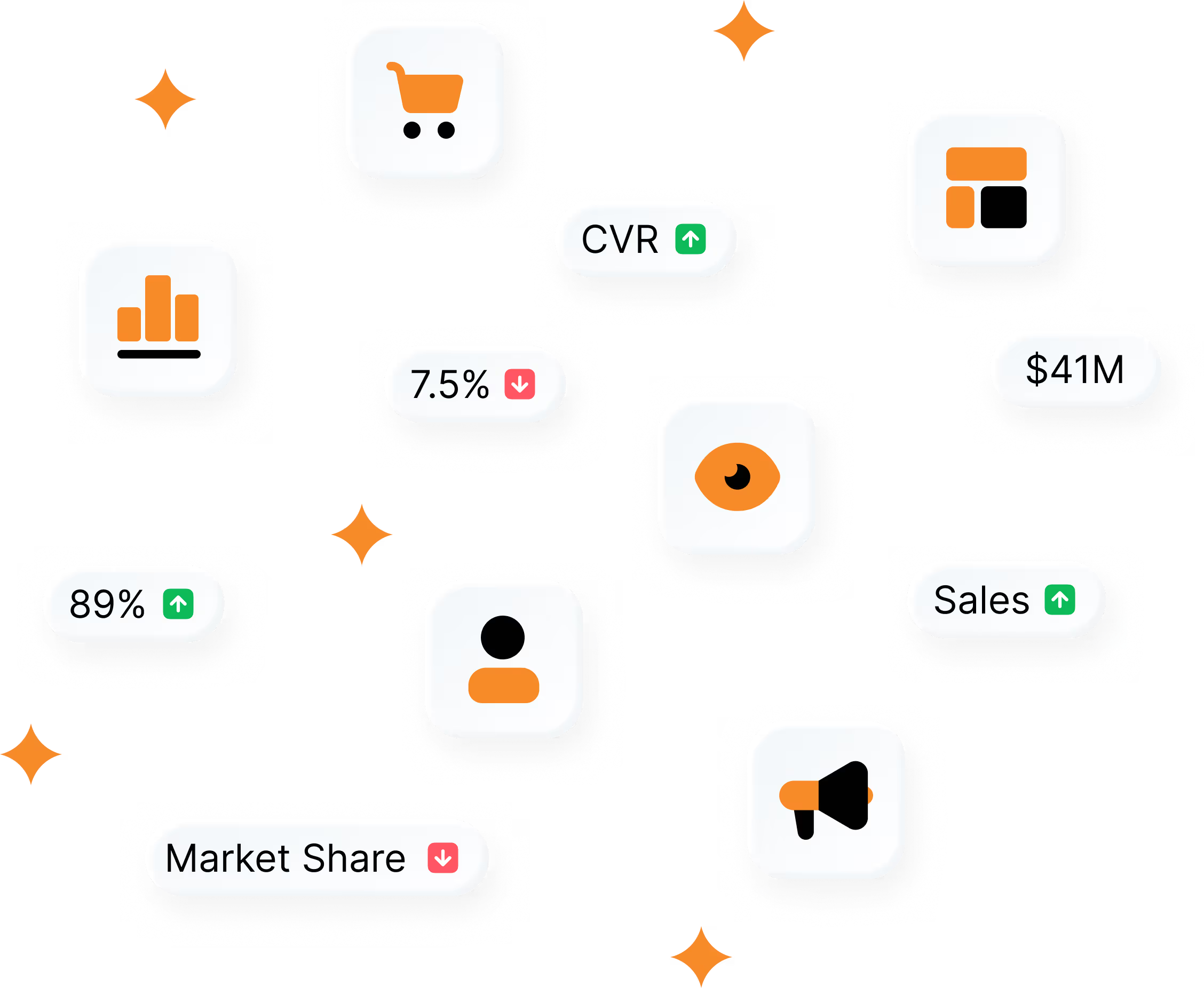The engine behind every strategy we run
Nexus takes care of the behind-the-scenes work most teams get buried in, so we can use that time to focus on the real questions: what’s working, what’s not, and where to go next.


.avif)
The problem is lack of clarity.
Things move quickly. Categories shift, shopper behavior changes, and leadership needs answers that translate to decisions. Tools can drown you in data, but they rarely connect it to your strategy or your P&L.

Clarity > volume
Too many metrics just freeze people up. What matters is seeing the few things that actually tell you where to move next.

Strategy needs structure
Without consistent tagging and reporting, it is impossible to see what is actually working by sub-brand, product type, or strategy segment.

Context matters
Is the movement because of you, or the entire category? That clarity makes it easier to defend results and decide what to do next.
.avif)

1. Automation → Our team spends more time on strategy
Bid adjustments aligned to ROAS and AOV targets
Dayparting support and blacklist rules for sensitive campaigns
Budget pacing and visual guardrails to keep spend on plan

Faster optimizations without constant manual churn
Cleaner pacing that reduces end‑of‑month chaos
More time from senior minds on creative tests and larger strategic moves
2. Custom tagging and tracking →Reporting tells a clear story
Campaigns tagged by strategy, brand, product type, and custom segments
ASIN‑level tagging that shows us performance by segment, product, and sub‑brand
One taxonomy that travels across reporting views

Clear views of branded vs category, visibility vs efficiency, and product‑type performance
Easier executive conversations since reporting mirrors how your business is actually organized
Faster root‑cause analysis when something moves
3. Search Term Scrape → Our team spends more time on strategy
Identifies converting search terms and ASIN targets you are not actively bidding on
Cleans and groups terms by product type and strategic intent
Stages campaigns with branded vs category separation

New coverage where it matters and quicker
Better keyword portfolios that reflect how shoppers actually search
Less waste and more qualified traffic
4. Bulk Launcher and Bid Ops → Speed to market, at scale
Launches campaigns across ad types for one or many ASINs in minutes
Applies consistent guardrails for bids, budgets, and negative logic

Rapid testing, quicker learnings, faster iteration cycles
Consistent quality even as scale increases
5. Coverage tool→ No blind spots
Holistic view of ASIN coverage by ad type
Over or under investment flags based on spend share vs revenue share

Confident coverage across the portfolio, with intentional pushes or pullbacks
Balanced spend that maps to where revenue is actually coming from
6. Drilldown tool → Granular cause and effect
Target and ASIN level shifts across impressions, clicks, CPC, CVR, CTR, ROAS
Find targets that used to perform, diagnose why they fell off, and address it
.avif)
Fewer surprises and faster fixes when a winner cools off
Clear evidence that connects changes to actions
7. Category benchmarks →Decisions with context
CVR, Add to Cart, Subscribe and Save, New‑to‑Brand, Page Views compared to median and top performers

Presentable context that explains market‑wide shifts
Confidence to hold the line or pivot with reason
8. AMC Powered Analysis → A Connected Customer Journey
Path to purchase sequences across ad types
Time to convert, halo ASIN impact, new‑to‑brand drivers
Audience efficiency, frequency, geo and device insights
Multi‑touch attribution, conversion depth, incrementality studies

Proof of how top‑funnel media improves lower‑funnel efficiency
Better creative and audience decisions based on actual paths to purchase
Clear guidance on cadence and frequency that avoids fatigue while preserving reach

.svg)
Reporting you’ll actually love
It’s not data for data’s sake. Nexus reporting is built to answer the exact questions your team and your CFO are already asking.
.svg)
Performance by placement
Which ad placements drive the most return (Top of Search, Detail Page, Homepage, Off-Amazon, Sponsored TV).
.svg)
See which placements deliver the best returns and where you’re overspending.

Performance by Segment
Branded, category, visibility, auto, ranking, efficiency.
.svg)
Understand how each strategy segment is really performing — and where to shift investment.

Performance by search term
Wins, waste, opportunities.
.svg)
Know which keywords drive growth, which drain budget, and where new opportunities live.
.svg)
Product and sub-brand views
SKU-level totals, TACOS, ad-to-total revenue mix.
.svg)
See how performance breaks down across products or sub-brands, and how ads contribute to overall sales.
.svg)
store performance
Storefront effectiveness (dwell time, visits, bounce rate).
.svg)
Understand how shoppers interact with your storefront and where they fall off.
.svg)
Amazon DSP reporting
What it shows: WoW, MoM, YoY trends, audience, device, geo, frequency.
.svg)
Track DSP performance across time, audience, and channel so you know what’s working long-term.
.svg)
Ad type overlap (AMC)
How SP, SB, SD, DSP interact.
.svg)
Understand how different ad types work together and where they overlap to drive conversions.
.svg)
NTB performance (New-to-Brand)
New vs existing customers.
.svg)
See which placements deliver the best returns and where you’re overspending.
.svg)
Funnel efficiency
Conversion efficiency at each step.
.svg)
Quickly see where customers fall off in the funnel and how efficient your path to purchase really is.

You get the best of both worlds: a team focused on strategy and craft, backed by technology built to handle complexity, keep pace with change, and make decisions easier to make and easier to defend.

